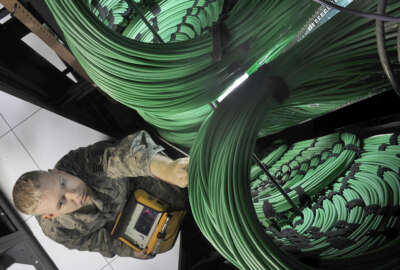
Army investing in 5G switches that will save energy
The new technology could be 50 times more energy efficient.
As the Defense Department is expanding the areas where it is testing 5G networks, the Army Research Office is looking into how it can better the use of 5G in devices.
The ARO is teaming up with the University of Texas at Austin and the University of Lille in France to make switching to and from 5G networks more than 50 times more energy efficient.
“All these communications systems use switches to switch between different frequencies,” Pani Varanasi, division chief of the materials science program at ARO told Federal News Network. “When they do this there is always some energy loss. What we’d like to do is minimize the loss of energy. Using 5G you’ll be downloading a lot of data and your battery will go dead pretty soon and you’d have to recharge often. That’s not very convenient for consumers.”
Varanasi said the components used in devices need to use less energy. The team’s switches use the nanomaterial hexagonal boron nitride.
“The structure of the switch involves a single layer of boron and nitrogen atoms in a honeycomb pattern sandwiched between a pair of gold electrodes. Hexagonal boron nitride is the thinnest known insulator with a thickness of 0.33 nanometers,” according to ARO.
The switches are already being utilized in cell phones today, but for 4G. Varanasi said moving to 5G involves using the different components.
“If we have smart homes with many components you’ll be constantly switching between different connections,” Varanasi said. “You’ll be switching between Bluetooth to WiFi to 4G to 5G. Whenever you are switching between these different frequencies you’ll be required to have a switching operation which takes energy consumption. 5G is expected to drain your battery really quickly because not everything is on 5G so you’ll be switching back and forth.”
The 5G switch concept is still in the early stages of basic research and it needs more work before it can be used. The research is being conducted through a grant from ARO in addition to a Presidential Early Career Award for Scientists and Engineers, the Office of Naval Research and the National Science Foundation.
The application of the switches isn’t only for cell phones, however. Satellite systems, smart radios, reconfigurable communications, and internet of things products can all use the switches.
“These switches can be realized on flexible substrates making them suitable for soldier wearable radios and communication systems that can benefit from the improved energy efficiency for longer battery life with faster data speeds as well as other defense technologies,” the ARO statement states.
DoD announced earlier this week that it is deepening its testing of 5G networks, which the devices using switches will connect to.
Seven new bases, in addition to the five already announced, will experiment with things like 5G ship-wide connectivity, augmented reality support of maintenance and training and wireless connectivity of forward operating bases.
“This latest tranche builds upon DoD’s previously announced 5G prototyping and experimentation plan, as well as the recently released Department of Defense 5G strategy,” Joseph Evans, DoD technical director of 5G, said Wednesday at the Pentagon via teleconference with reporters. “The bases that were selected were selected for their ability for large scale test facilities to enable rapid experimentation, as well as dual-use application prototyping.”
Copyright © 2025 Federal News Network. All rights reserved. This website is not intended for users located within the European Economic Area.
Scott Maucione is a defense reporter for Federal News Network and reports on human capital, workforce and the Defense Department at-large.
Follow @smaucioneWFED





